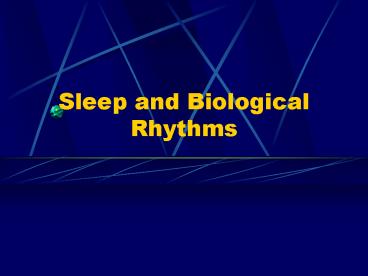Sleep and Biological Rhythms - PowerPoint PPT Presentation
1 / 30
Title:
Sleep and Biological Rhythms
Description:
Muscle tone (EMG) Brain wave activity. Synchrony vs desynchrony. Eye ... Loss of muscle tone (paralysis) Vivid, emotional dreams. Signs of sexual arousal ... – PowerPoint PPT presentation
Number of Views:256
Avg rating:3.0/5.0
Title: Sleep and Biological Rhythms
1
Sleep and Biological Rhythms
2
Lecture Outline
- Stages of sleep
- Sleep function
- Neural control of sleep
- Sleep Disorders
- Rhythms
3
EEG Studies of Sleep
- Sleep/waking cycle is experienced each day
- Physiological changes that occur during sleep
- Muscle tone (EMG)
- Brain wave activity
- Synchrony vs desynchrony
- Eye movements
- Genital activity
4
Alpha 8-12 Hz Beta 13-30 Hz Theta 3.7-7.5
Hz Delta lt 3.5 Hz
5
Non-REM Sleep
- Alpha, delta, theta activity in the EEG
- Stages 1 and 2 theta
- Stages 3 and 4 delta activity (synchronized)
- Termed slow-wave sleep (SWS)
- Light, even respiration
- Muscle control is present (toss and turn)
- Dreaming
- Difficult to rouse from stage 4 SWS (resting
brain?)
9.9
6
REM sleep
- Presence of beta activity (desynchronized)
- Enhanced respiration and blood pressure
- Rapid eye movements (REM)
- PGO waves
- Loss of muscle tone (paralysis)
- Vivid, emotional dreams
- Signs of sexual arousal
- Assess impotence stamps versus the sleep lab
7
Cycling of SWS and REM
1. SWS precedes REM sleep 2. REM sleep
lengthens over the night 3. Basic sleep cycle
90 minutes
8
(No Transcript)
9
What is the Function of Sleep?
- Sleep as an adaptive response?
- Found in all vertebrates (REM in mammals)
- Kept our ancestors our of predators way?
- Restoration and repair?
- Reduced brain activity during SWS
- Changes in sleep duringProlonged bed rest (no
real changes in SWS) - Exercise (temperature inc. gt inc. SWS)
- Mental activity increases SWS
9.12
10
Sleep Deprivation Studies
- Human Sleep Deprivation
- Peter Tripp 200 hrs sleep deprivation produces
psychosis - Randy Gardner sleep deprivation does not induce
psychosis - Perhaps drugs taken by Tripp contributed to
psychosis - Sleep deprivation impairs cognitive functions
- Perceptual distortions and hallucinations
- Animal Sleep Deprivation Studies
- Rats forced to walk lose sleep
- Eat more, increased activity, illness and then
death
9.13
11
(No Transcript)
12
Sleep Functions
- SWS may reflect restoration
- REM sleep may reflect
- Vigilance alertness to the environment
- Consolidation of learning/memory
- Flushing of useless information
- Facilitation of brain development
13
Chemical Modulation of Sleep/waking?
- Notion of sleep-promoting or wakefulness-promoting
factors? - Unlikely given
- Siamese twins share circulatory system but sleep
independently - Bottle-nose dolphins two hemispheres sleep
independently - But adenosine receptor stimulation increases slow
wave sleep
14
Sleep in Bottle-Nose Dolphins
Figure adapted from Mukhametov, L.M. in Sleep
Mechanisms, edited by A.A. Borbely and J.L.
Valatx. Munich Springer-Verlag, 1984.
15
Neural Regulation of Arousal
- Electrical stimulation of brainstem induces
arousal - Dorsal path RF--gt to medial thalamus --gt cortex
- Ventral path RF --gt to LH, basal ganglia,
forebrain - Neurotransmitters involved in arousal
- NE high activity when wake, low during sleep
(LC) - ACh agonists increase arousal, antagonists
decrease arousal - 5-HT raphe nuclei activity is low during sleep
- 5-HT neurons were most active during wakefulness,
activity declined during SWS, and reached 0
during REM sleep
16
Locus Coeruleus and Arousal
- NE secretion inhibits sleep (amphetamine)
- Lesions of ascending LC fibers increase REM,
slow wave sleep - Correlation of LC NE neurons with sleep-waking
cycle - LC firing rate declines during REM sleep
- LC firing rates increases on awakening
17
(No Transcript)
18
- Physiological Mechanisms of Sleep and Waking
- Neural control of slow-wave sleep
- Ventrolateral preoptic area (VLPA)
- A group of GABAergic neurons in the preoptic area
whose activity suppresses alertness and
behavioral arousal and promotes sleep. - Destruction of this area has been reported to
result - in total insomnia, coma, and eventual death in
rats.
19
(No Transcript)
20
(No Transcript)
21
(No Transcript)
22
Dorsolateral Pons and REM Sleep
- Pontine neurons initiate REM sleep
- PGO waves are first predictor of REM sleep
- ACh levels elicit PGO waves
- Increased ACh increases REM sleep
- Decreased ACh decreases REM sleep (kainic acid
lesions) - Pontine lesions decrease REM sleep (Israeli
soldier) - Pontine cells project via magnocellular cells
within medulla to the spinal cord release
glycine to inhibit alpha-motoneurons (induce
paralysis or atonia)
23
(No Transcript)
24
(No Transcript)
25
(No Transcript)
26
Sleep Disorders
- Insomnia Difficulty in sleeping
- Many causes situational, drug-induced
- Sleeping pills drug-dependence insomnia
- apnea
- Narcolepsy Sleep at odd times
- Sleep attack urge to sleep
- Cataplexy REM paralysis
- Sleep paralysis
- Hypnagogic Hallucinations
27
Sleep Disorders
- Parasomnias
- Night terrors
- Enuresis
- Sleep-talking
- Sleep-walking
- REM w/o atonia
- Myoclonic jerk reflex
- PLMD- Periodic limb movement disorder
28
Biological Rhythms
- Behaviors display rhythmic variation
- 90 minute rest-activity cycle
- Circadian about a day
- e.g. sleep/waking cycle, temperature
- Monthly rhythms
- Menstrual cycle
- Seasonal rhythms
- e.g. aggression, sexual activity in deer
29
SCN and Circadian Rhythms
- Suprachiasmatic Nucleus (SCN) contains a
biological clock that governs circadian rhythms - SCN receives input from retina (light resets
clock) - SCN lesions disrupt circadian rhythms
- SCN clock cells do not require direct neural
connections to control circadian rhythms
30
SCN Biological Clock
- SCN cells exhibit circadian rhythms
- Involves glucose metabolism
- Appears to be synchronized by SCN chemicals
- Nature of clock
- Fruit fly analogy
- Activity of PER and TIM genes
- Light pulses inhibit TIM gene
- Resets circadian cycle































